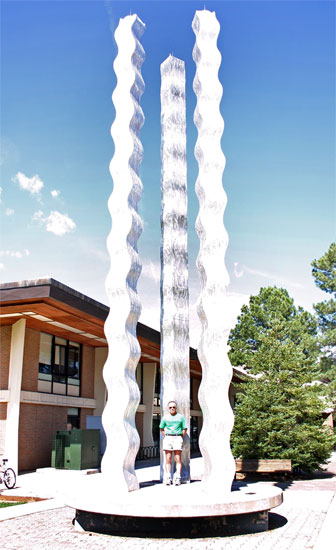
Art professor Jim O’Hara has been riding a wave on campus since he built one almost 25 years ago.
He designed the tall and shiny “Benchmark” sculpture on south campus “to involve a lot of people and to represent a place of comings and goings, positives and negatives and the wave in all things,” says the sculptor.
Nicknamed the “French Fries” for the three rippling 40-foot-high pillars, there is more to this piece of art than meets the eye.
Built by O’Hara and students in 1983 and 1984 as part of an architectural sculpture class project, the “Benchmark” was designed to serve multiple purposes.
For NAU, it was an artsy way to eliminate exhaust emanating from a pistol range that was then located in the basement of the du Bois Center.
O’Hara and his students used recycled fabricated aluminum sheets to weld together the wavy shapes to hide the 24-inch diameter steel tube that led the smoke underground through the building to a three-way manifold and high into the air. They made the sculpture strong, too. It can withstand winds up to 200 mph.
For O’Hara, the sculpture was a chance to design the first major piece of site-specific outdoor art in Flagstaff and to work with a shape that “fascinates” him.
“With the wave shape you can show how nature works, and you can create all sorts of illusions,” he said. “If you look at these pieces from one angle, they appear to have three perfectly straight parallel lines, but if you move 90 degrees, they turn into a wave. Sometimes at noon, the piece picks up the blue from the sky and becomes transparent.”
O’Hara also designed the sculpture to convey an icy look when it snows and a waterfall effect when weather is hot. When the sun goes down, the lights on the sculpture also cause it to look like flowing water.
“When the red, yellow and blue lights are on, it illustrates a heat oxidation spectrum that starts at the bottom as blue and travels up and evaporates into a gold color,” O’Hara noted. “It does this sort of crawling thing and looks like it is moving.”
His 15-foot high “Portal with Doors and Waves” sculpture, featuring numerous small metal waves, is a landmark in Tucson’s Reid Park.
O’Hara continues to teach design at NAU and now is working on incorporating the wave shape into smaller glass artwork, represented in galleries in Phoenix, California and in the Midwest.



